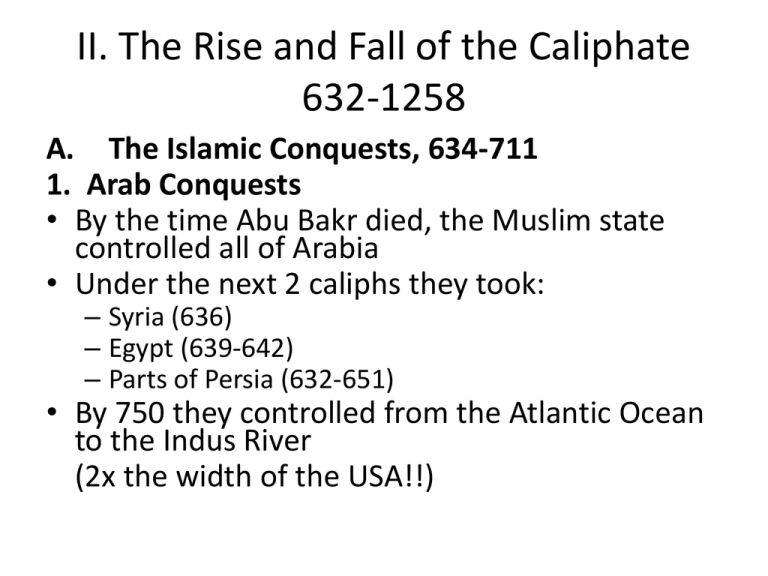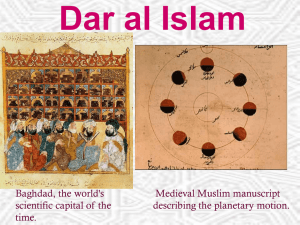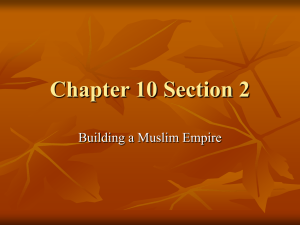Abbasid Caliphate
advertisement

II. The Rise and Fall of the Caliphate 632-1258 A. The Islamic Conquests, 634-711 1. Arab Conquests • By the time Abu Bakr died, the Muslim state controlled all of Arabia • Under the next 2 caliphs they took: – Syria (636) – Egypt (639-642) – Parts of Persia (632-651) • By 750 they controlled from the Atlantic Ocean to the Indus River (2x the width of the USA!!) II. The Rise and Fall of the Caliphate 632-1258 Warm Up: • What was the extent of the Islamic Empire as of 750 C.E.? II. The Rise and Fall of the Caliphate 632-1258 2. Why were Arab armies so successful? • Their enemies were weak - The Persian and Byzantine Empires had fought a series of wars against each other - Weakening both II. The Rise and Fall of the Caliphate 632-1258 • Nomadic Heritage - Many of the Arab fighters were nomads - they were used to fighting battles in the desert and travelling a long way from home. II. The Rise and Fall of the Caliphate 632-1258 • Motivation - Muslim fighters who died fighting a Jihad or holy war believed they would go to heaven when they died - Religion served as a unifying factor for the Arab armies II. The Rise and Fall of the Caliphate 632-1258 3. Conquered Territory • The caliph Umar prohibited Arabs from assuming ownership of conquered lands • In order to serve in the army, and receive pay, soldiers needed to live in military camps • Kept the armies together, ready for action • Preserved life in the countryside • A small number of Arabs ruled of a vastly larger nonArab population • No evidence of forced conversions or missionary activity II. The Rise and Fall of the Caliphate 632-1258 B. The Umayyad and Early Abbasid Caliphate 661-850 1. Umayyad Rule • Capital in Damascus • Adopted administrative structure of Byzantines and Sasanid predecessors • Majority population was non-Muslim • Army almost entirely Muslim Arabs II. The Rise and Fall of the Caliphate 632-1258 2. Fall of the Umayyad Caliphate • Converts to Islam resented not achieving equal status to Arabs • Some Muslims looked down on the wealth and bad behavior of the caliphs • Shi’ites launched rebellions, attacking the legitimacy of Umayyad caliphs. • Rebellions overthrew the Umayyads in 750; • one branch of the family, however, remained in power in Spain. II. The Rise and Fall of the Caliphate 632-1258 3. The Abbasid Caliphate 750-1258 • Shi’ites helped overthrow the Umayyad caliphs • Revolt was coordinated by the family of Abbas, one of Muhammad’s uncles • Established the Abbasid Caliphate • Capital in Baghdad II. The Rise and Fall of the Caliphate 632-1258 4. Literature and learning • “golden age” • the translation of Greek texts and secular Arab poetry, thrived under the Abbasids. • Baghdad was a center of Abbasid culture • the rate of conversion of non-Muslim subjects to Islam in the ninth century increased. II. The Rise and Fall of the Caliphate 632-1258 C. Political Fragmentation 661-850 1. Decline • caliphs found it impossible to maintain control over their vast territory. - difficulty of transportation and communications • Resentment of rule of Baghdad by local leaders II. The Rise and Fall of the Caliphate 632-1258 2. Mamluks • the caliphs had come to rely on Turkish slave troops known as Mamluks • In the late ninth century, when they were not paid properly, the Mamluks took control of the caliphate II. The Rise and Fall of the Caliphate 632-1258 3. Fragmentation • in 945, the caliphate fell under the control of the Iranian Shi’ite Buyids. • As the Abbasid Caliphate declined, various provincial regimes rose to power. - the Samanids in Central Asia and the Fatimids in Egypt. II. The Rise and Fall of the Caliphate 632-1258 4. al-Andalus • Islamic, Roman, German, and Jewish cultures combined to form a unique Islamic civilization in Spain. Muslim Spain: • urbanization, • the introduction of citrus crops, • a diverse irrigated agricultural sector, • and a growth of Muslim and Jewish intellectual activity. • Religious tolerance II. The Rise and Fall of the Caliphate 632-1258 D. Assault from Within and Without, 1050-1258 1. Seljuk Turks • took advantage of the decline of the Abbasids • established the Suljuk Sultanate. • The Seljuks ruled a territory stretching from Afghanistan to Baghdad • took Anatolia from the Byzantines in 1071. - Battle of Manzikert II. The Rise and Fall of the Caliphate 632-1258 2. Turkish Rule • Pastoral Turks had little interest in urban life • Cities shrank • Irrigation systems were not maintained • Tax revenue fell • Baghdad fell to ruins • Mesopotamia would never again regain its geographic importance II. The Rise and Fall of the Caliphate 632-1258 3. Invasions • Crusades began in 1099 - Defeated by Kurdish leader, Saladin who unified Egypt and Syria • Mamluk’s overthrow decedents of Saladin in 1250 • Mongol invasions - Destroyed the Abbasid Caliphate in Baghdad in 1258 - Mamluk’s from Egypt defeated the Mongols in 1260 • Mamluk Sultans ruled Egypt until 1517











